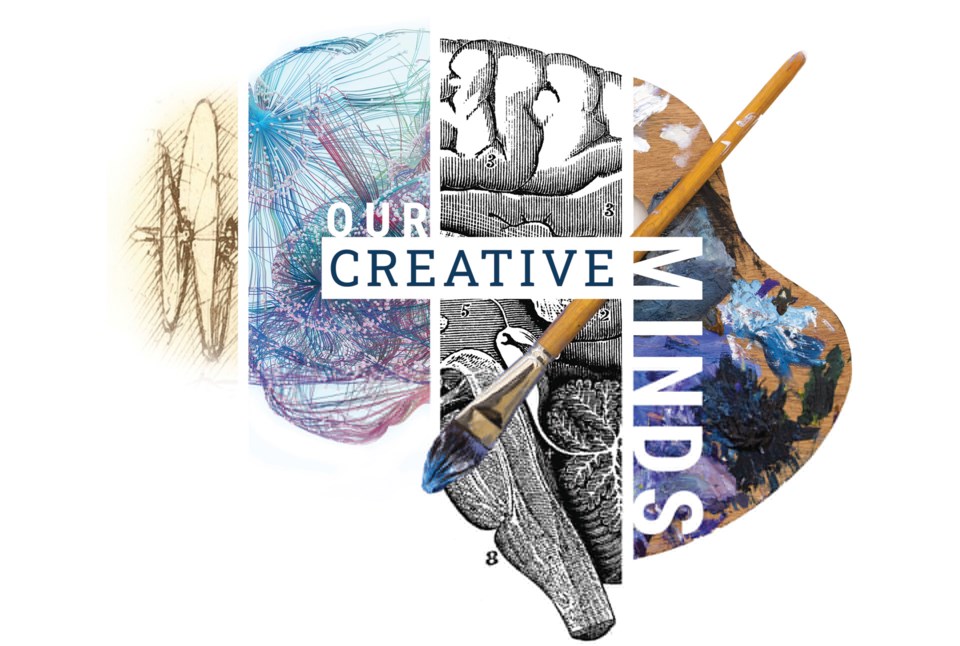It’s the late 1490s, and painter and inventor Leonardo da Vinci is sketching, prototyping, and creating wing after wing, determined to build a set that can achieve human-powered flight.
Fast forward a few hundred years, to a classroom at Skyline High School. Here, senior Minh Miller is creating a very different set of wings. Feather by feather, she is sending designs to a laser cutter for a falcon wing art installation by her school’s chapter of the National Art Honor Society.
Shared by both projects is a blending of the arts and sciences. Refusing to see them as separate fields, da Vinci is perhaps the most famous practitioner of what we now call STEAM (Science, Technology, Engineering, Arts, and Math) education. Minh is carrying on this tradition as the first student to simultaneously complete both the STEM Academy and the Visual and Performing Arts (VPA) Academy at Skyline High School. The arts play a crucial role in building the infrastructure of learning all of these other subjects, while also developing key skills for life.
“No such thing as mistakes, just happy little accidents.” - Bob Ross
Study after study over the past couple of decades has demonstrated that arts participation and arts education have been associated with improved cognitive, social, and academic performance. Students who participate in arts education are five times less likely to drop out of school and four times more likely to be recognized for high achievement.
The reason for this might lie within our brains themselves. Arts participation is shown to help increase our brain’s plasticity, the ability to adapt in response to new experiences. Basically, it helps us create new synapses and connections – also known as learning. In their book, Your Brain on Art, Susan Magnussen, Director of International Arts + Mind Lab at Johns Hopkins University, and Ivy Ross, Google’s Vice President for Hardware Design, write that “art enhances the ability of your brain to perform the tasks they were designed to do by increasing the synaptic circuits.”
Art accesses advanced parts of the brain that relate to our executive functioning, which includes time management, retention of information, collaboration, and more. It helps us focus, express ourselves, and have patience for the process while learning from mistakes.
A group of seven fifth grade students sit in a circle in their classroom at Sanborn Elementary School, agreeing energetically that while they all had different favorite projects in art class – watercolor, pottery, and perspective drawing are the most mentioned – their favorite aspect of each was the challenge. “My favorite part of coming to class is probably when our teacher, Mr. Johnson, reveals what we’re going to be working on, because it’s always something different,” summarizes Arianna Guttierrez, one of the fifth graders. “And sometimes it can be easy, or sometimes it can be hard, but it’s practice no matter what, and it can help you grow.”
Shane Johnson, Art Teacher at Sanborn Elementary, adds that his art classroom is a place where students can make mistakes and grow from them. “If they mess up or don’t like how a project turned out, they can try again. Our goal is to grow that mindset of, ‘I can do hard things,’ which is something they can take beyond our classrooms and into the world, no matter what age.”
Arts education is particularly powerful from an early age, providing scaffolding for future learning. St. Vrain is proud to have arts classes at every level as a key part of its comprehensive education. At Sanborn Elementary, core to Johnson’s teaching philosophy is that art is interconnected with every other subject and can help drive home things taught in other classrooms in tangible, powerful ways. “What they’re learning in math class, I can reiterate in my art class,” says Johnson. “Art is the world where all of the aspects of their education can come together. Whether it’s math, history, technology, or actual physical application, they can take these abstract concepts and put them to a concrete application in their art projects.”
“Art and science are the highest forms of human creativity.” - Ellen Jorgensen, Molecular Biologist
While the arts help build skills in every field, they are particularly relevant to STEM education. At the high school level, in her engineering courses, Minh realized the design-thinking process of empathize, define, ideate, prototype, test, evaluate, and repeat, is extremely similar to the Studio Habits of Mind process learned in her art courses: develop craft, engage and persist, envision, express, observe, reflect, stretch, and explore. “I realized I’ve been combining the two the entire time.”
In an independent study, Minh leaned into this as she researched, designed, and printed a lampshade for the lights in her French classroom. She had to find ways to blend the aesthetic ideas for her shade with the practical needs of fire safety and materials, all the while using her knowledge of computer-aided design (CAD) software and 3D printing.
The visual arts require many of the same skills as scientific inquiry and innovation. Both processes are fueled by curiosity and tactile learning. In addition, visual arts nurture the ability to envision and communicate both abstract concepts in science on one level, or complex feelings that younger students might not yet have the words for on another.
“I think art is important in or out of school because it helps you grow your perspective on things, and the more ways you can see other things, the more ways you learn,” notes Arianna, back in Mr. Johnson’s classroom.
Creativity, curiosity, problem-solving, and communication – these are the essential skills for future success in a world of rapid change and innovation. As we prepare students for this future, St. Vrain Valley Schools’ is instilling an arts education as a foundation for success for all of our students to give them a strong competitive advantage.


